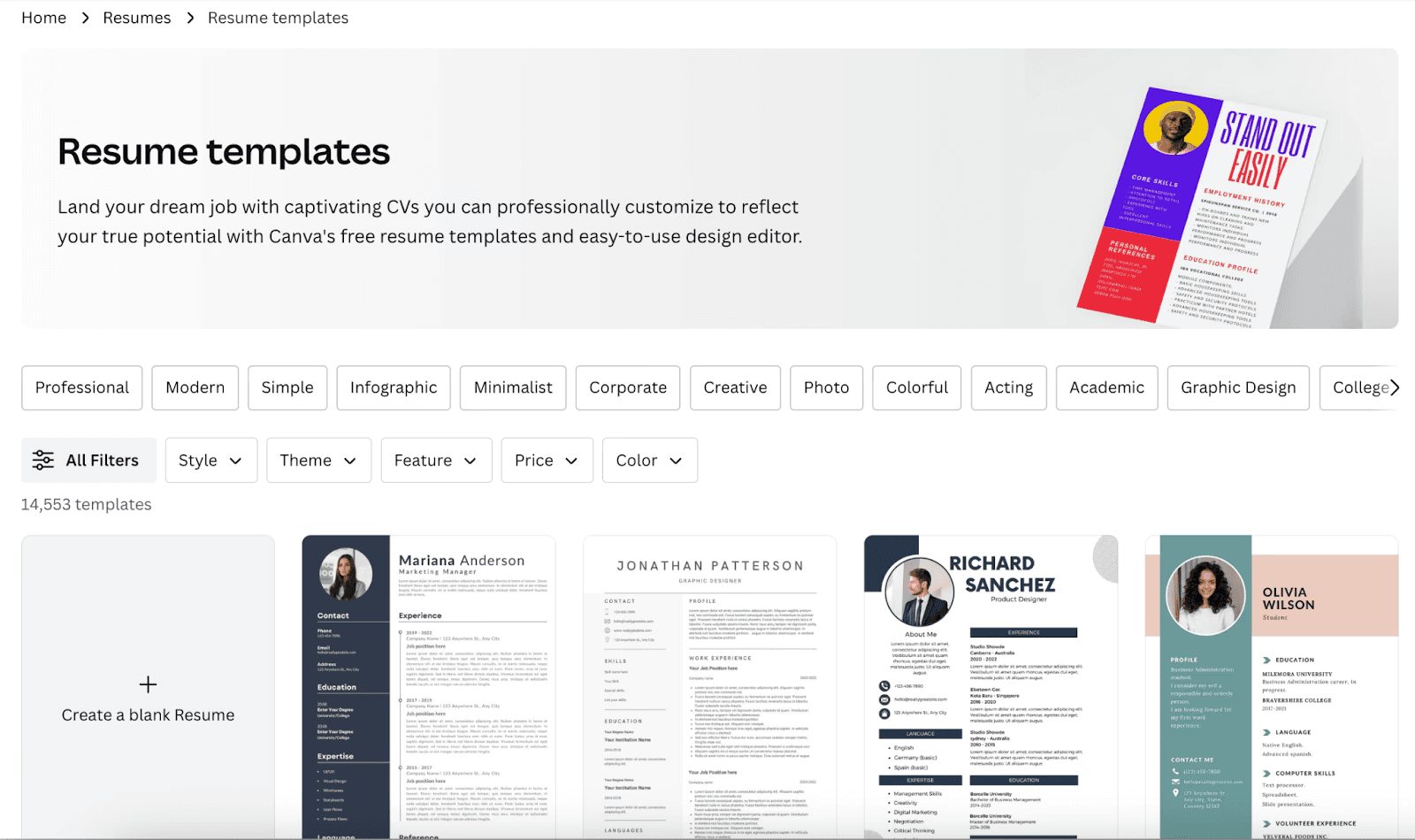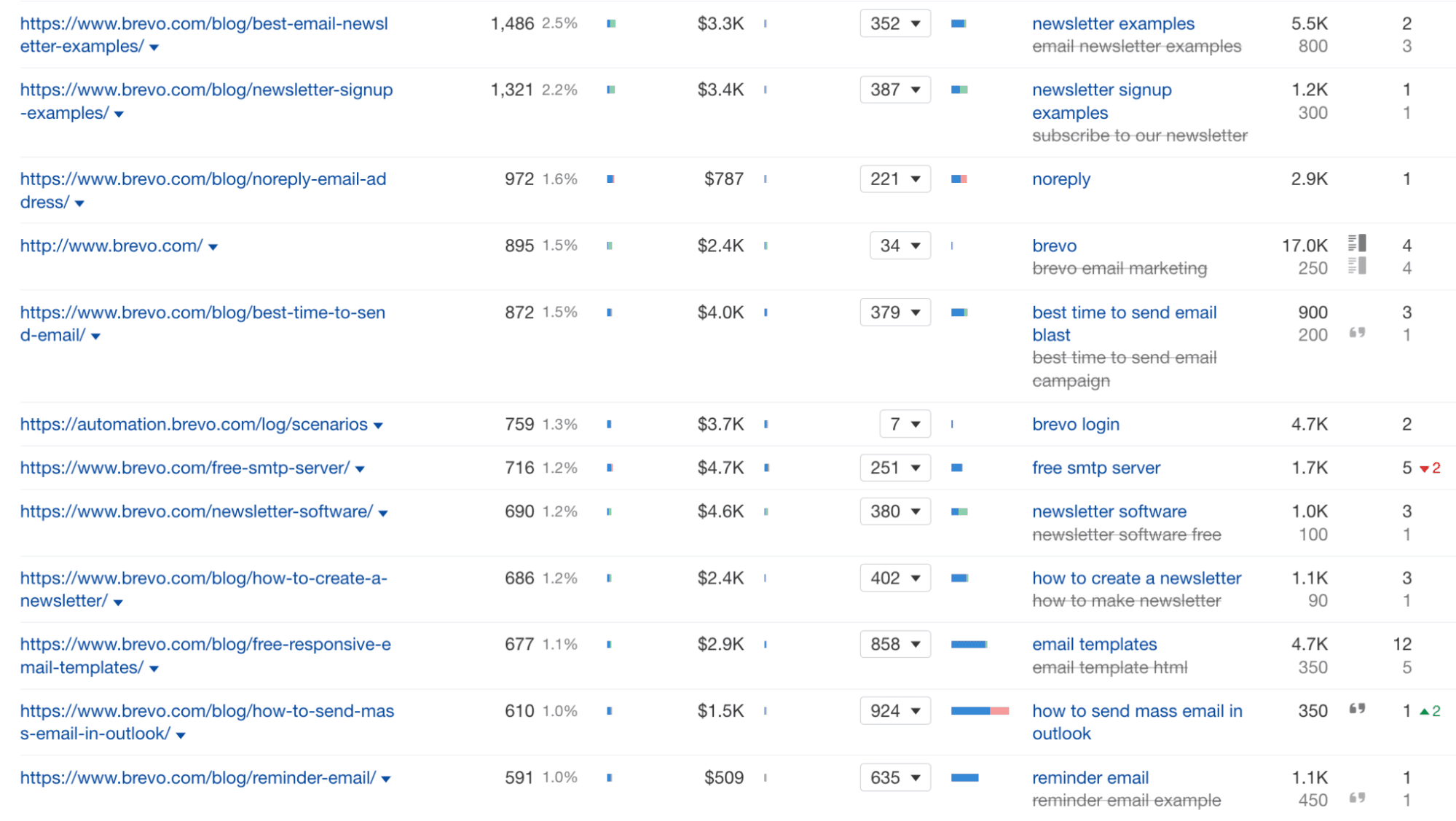How to replicate the “template” pSEO strategy used by Canva, PandaDoc, and others
Companies like Canva and PandaDoc have successfully implemented a powerful programmatic SEO (pSEO) strategy known as the "template" playbook. This strategy capitalizes on long-tail keywords related to specific user needs, offering customizable templates that can be personalized within the company's platform.
If your platform offers customization for various use cases, there could be an opportunity to generate templates that enable your potential customers to discover (and start using) your product more quickly.
Examples of the template pSEO strategy in action
Canva has masterfully implemented the template pSEO strategy, creating an ecosystem of thousands of pages that target specific design use cases, from "birthday invitation templates" to "business proposal templates." Each page showcases relevant designs that users can customize within Canva. Canva has created over 21,000 template pages that draw in over 13 million monthly organic visits (per Ahrefs data).

PandaDoc, an all-in-one document automation platform, enables sales teams to create, approve, and e-sign proposals, quotes, and contracts. To capture sales professionals searching for proposal, quote, and contract templates, PandaDoc created a library of more than 1,000 templates for users to customize within the platform. This strategy yields over 140,000 monthly organic visits (per Ahrefs data).

Why the template pSEO strategy works
The template pSEO strategy is particularly effective for platforms offering customizable design or productivity tools. It provides several key benefits:
Immediate value and user intent matching: Users typically have a clear goal when searching for specific templates. By providing exact matches to these searches, companies can reduce friction and minimize the steps between discovery and use.
High conversion potential: Users searching for templates are typically prepared to start a project immediately. These searchers have identified their needs and are actively seeking a tool to address them.
Scalability: Once a template page format is established, it can be applied across various categories and subcategories. Companies can use search trend data to identify new template opportunities and quickly create corresponding pages. For example, in response to the shift to remote work during COVID-19 and the need for video conferencing, Canva created Zoom background templates, which now draw in about 85,000 monthly organic visits (per Ahrefs).

Steps to build a template pSEO engine
Step one: Identify product-related content opportunities
Start by looking at your existing user profile — who uses your product, and how do they use it? This analysis will form the foundation of your long-tail keyword strategy. For example, Mailchimp, a marketing automation and email platform, caters to marketing professionals. Their list might look something like this:
Personas
Content marketer
Demand generation manager
Social media manager
Product marketing manager
Use cases
Emails
Birthday bonus email
Welcome email
Sitewide sale promotional email
Newsletter subscriber email
Etc.
Landing pages
Free trial sign-up
eBook download
Webinar registration
Newsletter sign up
Etc.
Social media posts
Instagram ad
Instagram carousel
Facebook advertisement
LinkedIn banner
Etc.
Once you’ve built a starter list, you can start to see the pSEO page opportunities:
[Persona] + landing page + [use case] + template
[Persona] + email + [use case] + template
[Persona] + social media + [use case] + template
Step two: analyze competitors to identify content gaps and opportunities
Use a tool like Ahrefs to evaluate your competitor’s organic traffic and identify topic opportunities. You likely know your competitors by heart, but you can also use Google to search “top [your company name] competitors” or use a tool like Ahref’s “organic competitors” functionality to discover your top organic competitors.
A quick Google search for “Mailchimp competitors” offers the following result.

You’ll want to generate a list of at least 10-15 competitors, which you will then narrow down to those that meet a certain organic traffic threshold (we recommend at least 50,000 monthly organic visits without factoring in traffic to the homepage). This typically narrows the list to about 3-5 competitors.
For Mailchimp, the narrowed list of direct competitors includes:
Hubspot
ActiveCampaign
Brevo
GetResponse
Constant Contact
Use a tool like Ahrefs to see the top organic pages for each competitor and look for keywords related to “templates” or “examples.” For instance, Brevo’s top organic pages reveal keyword opportunities such as “best newsletter examples,” “newsletter signup examples,” and “email templates” all appear on Brevo’s top organic pages.

While Brevo primarily relies on generic, listicle-style content to attract organic visits for these topics, Mailchimp could expand on these competitive keywords and their long-tail variations by providing customizable, ready-to-use templates that directly address users’ niche needs. This approach offers several advantages compared to Brevo’s content:
Immediate value: Users can quickly implement solutions rather than just reading about them.
Long-tail keyword targeting: Templates can be optimized for highly specific search queries.
Enhanced user experience: Visitors find actionable resources tailored to their exact requirements.
Ultimately, the goal of your competitive research is to identify either:
Competitors that are already using the template pSEO playbook and how you can differentiate from these competitors by topic or content quality.
Relevant template-related “head terms” captured by competitors (like the Brevo example above) and opportunities to implement a long-tail keyword strategy that expands on these terms.
Step three: build a page framework to support your pSEO strategy
Design a flexible page that accommodates your pSEO strategy's long-tail keywords. Ideally, the page will allow users to interact with the template on your platform to achieve their task. To build an effective page framework, focus on the following key elements:
Align content with search intent. Use long-tail keywords in the H1 that exactly match search queries, e.g., “Social media content calendar templates.” Organize content hierarchically to emphasize specific features and functionality directly addressing the searcher’s needs.
Provide immediate value. Offer step-by-step instructions on how to use or customize the template. Implement a preview functionality that allows users to see high-quality images of the template, customize it, and start using it right away.
Drive conversions with user-centric design. Create a logical flow that leads users from their initial query to your product’s relevant features. Use prominent, action-oriented CTAs throughout the page, e.g., “Customize this template.”
Step four: Leverage a dataset to support your pSEO templates
Once the page components are defined, you’ll leverage and format an existing dataset to correspond with the page contents. For example:
Template name → H1 title
Category → H2 subheader
Description → Meta description and introductory paragraph
Key features → Bullet point list
Preview images → Template preview section
Related templates → Related template links

As you format your dataset, keep the following in mind:
Focus on unique, high-quality data: Use proprietary first-party data from your product if possible
Ensure data quality and consistency: Implement data cleaning practices to remove duplicates and fill in missing values
Check for spelling errors and formatting issues: Normalize data with consistent naming conventions and standardized units.
Create variations of key fields: Generate alternate versions of topics/headings for keyword variation.
Include SEO-specific fields: Add meta titles and descriptions, keeping them within character limits.
Consider scalability and updates: Design the dataset structure to allow for easy additions and updates.
Step four: Ship your pages and scale them!
After determining your target search patterns, crafting a template, and verifying that your data supports it, the next phase is to launch your pages on a larger scale. There are two main approaches:
Programmatic SEO SaaS Platform: For example, using daydream, you can easily design templates, integrate data from both internal and public sources, mass-produce pages, and upload them directly to your CMS.
Internal Development Team: Alternatively, you can assign the task of scaling programmatic pages to your internal engineering team. However, this option might be slower and costlier than opting for a tailored, out-of-the-box pSEO solution.
Work with us!
We’re working with some of the fastest-growing startups like OpenArt, Descript, and Twingate to help them accelerate their organic growth through AI-driven pSEO content.
Our team of SEO experts helps companies plan and execute high-performing pSEO strategies, while our SaaS platform provides all the tooling necessary to get a robust, high-performing pSEO engine up and running without the expensive price tag. With daydream, you can identify the most valuable long-tail search patterns related to your product and features, build and maintain comprehensive datasets to support your pSEO strategy, and programmatically generate 90th-percentile content at scale.
If you’re interested in using daydream and joining our growing list of customers, email us at thenukak@withdaydream.com to start the conversation.
